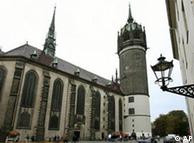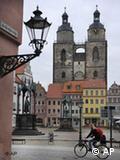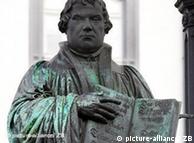Martin Luther's Table-Talk 節本/Melanchthon為馬丁‧路德所寫的第一篇傳記
British Museum
Wife of Martin Luther, Katharine von Bora, died #onthisday in 1552. See her portrait in #MemoriesOfANation http://ow.ly/Gb5Dz
Martin Luther was born #onthisday in 1483. His writings, including his 95 Theses, were the catalyst for the Protestant Reformation#MemoriesOfANation http://ow.ly/DYKNX
#onthisday in 1517: Luther nails his 95 Theses to a church door, sparking the Reformation http://ow.ly/DBJC0
See Luther's 1541 Bible with a dedication in his own hand in our exhibition #MemoriesOfANation http://ow.ly/CeCXL

Luther Table Talk:" Such were the fruits of forced celibacy?"
《管錐編》p.1543
同樣的翻譯本的引文/簡化
錢鍾書 引的沒在下書出現
此 書香港似乎有翻譯本待查
Martin Luther's Table-Talk
試看歐洲的宗教革新運動的歷史。馬丁‧路德(Martin Luther)和約翰‧高爾文(John Calvin)等人起來革新宗教,本來是因為他們不滿意於羅馬舊教的種種不容忍,種種不自由。但是新教在中歐北歐勝利之後,新教的領袖們又都漸漸走上了不容忍的路上去,也不容許別人起來批評他們的新教條了。高爾文在日內瓦掌握了宗教大權,居然會把一個敢獨立思想,敢批評高爾文的教條的學者塞維圖斯 (Servetus)定了「異端邪說」的罪名,把他用鐵鏈鎖在木樁上,堆起柴來,慢慢的活燒死。這是1553年10月23日的事。
德國人性行為的次數到底能否達到馬丁‧路德一年104次的標準,也是學者研究的內容。
www.lutherdansk.dk/Table-Talk/index1.htm - 頁庫存檔 - 翻譯這個網頁English translation of Martin Luther's Table-Talk. ... Divine Discourses at his Table, held with divers learned Men and pious Divines;
THE
OFTRANSLATED BY WILLIAM HAZLITT, Esq.Philadelphia:
The Lutheran Publication Society
Typed by: Kathy Sewell ksewell@gate.net
June 1, 1997
This book is in the public domain
________________

Martin Luther, Johannes Bugenhagen, Philip Melanchthon, Caspar Creuziger, Justus Jonas and Vitus Dietrich at the table (Original print 1558).
臺大歷史系講論會
Melanchthon為馬丁路德所寫的第一篇傳記 花亦芬老師主講(臺大歷史學系教授) 人文學者Philipp Melanchthon(1497- 1560)是馬丁路德(Martin Luther, 1483-1546)在德意志宗教改革過程中,最重要的「戰友」。路德過世後三個多月,Melanchthon為路德的拉丁文文集(Omnia Opera)第二冊寫了一篇〈路德傳〉作為序言(“Praefatio”)。這篇路德傳隨後以單行本(Historia D. Martini Lutheri) 流傳,成為後世(尤其是親基督新教陣營)認識路德生平與思想最重要的依據。換言之,我們今天對路德的認識受到這篇傳記影響甚深。這篇傳記不僅是第一篇關於 路德的傳記,在書寫上,Melanchthon也將宗教改革所有的奮鬥與成就歸給路德,絲毫不提自己長年的努力與付出。在這篇傳記影響下,德意志宗教改革 史的書寫也形成以路德個人為中心的傳統史觀。隨著現代宗教改革史研究多元視野的開展,近年來的研究除了跳脫以路德 為中心的英雄史觀,將當時一般社會大眾對路德改革思想的反應與民間宗教生活習慣的變動(與不變動)納為歷史觀照的範圍外,也開始檢視 Melanchthon對宗教改革運動的影響。本文希望以1546年Melanchthon所寫的《路德傳》為基礎,討論他為基督新教開創了何種傳記書寫 觀?這種書寫觀與古希臘羅馬的傳記以及中古的聖徒傳差異何在?對基督新教的意義又是甚麼?此外,雖然Melanchthon在《路德傳》裡沒有花費筆墨談 論自己對宗教改革運動參與的詳情,本文仍將析論,Melanchthon在字裡行間還是清楚表達出,自己何以要放棄如Johann Reuchlin(1455-1520)與Erasmus of Rotterdam(1466-1530)等人文學者可以安然享有的學術尊榮,不懼時代風濤,與路德並肩奮鬥長達二十七年有餘。透過這個闡析,本文將進一 步討論,Melanchthon的抉擇與他對提升德意志社會文化的思考有何關聯?這些思考又與路德的宗教思想以及Erasmus的人文學教育理想有何差 異?透過上述的討論,本文希望論述Melanchthon個人思想的獨立性,以此來重塑德意志宗教改革原本具有的多元風貌,並重新省思十六世紀宗教改革運 動的本質與特色。
試看歐洲的宗教革新運動的歷史。馬丁‧路德(Martin Luther)和約翰‧高爾文(John Calvin)等人起來革新宗教,本來是因為他們不滿意於羅馬舊教的種種不容忍,種種不自由。但是新教在中歐北歐勝利之後,新教的領袖們又都漸漸走上了不容忍的路上去,也不容許別人起來批評他們的新教條了。高爾文在日內瓦掌握了宗教大權,居然會把一個敢獨立思想,敢批評高爾文的教條的學者塞維圖斯 (Servetus)定了「異端邪說」的罪名,把他用鐵鏈鎖在木樁上,堆起柴來,慢慢的活燒死。這是1553年10月23日的事。
德國人性行為的次數到底能否達到馬丁‧路德一年104次的標準,也是學者研究的內容。
www.lutherdansk.dk/Table-Talk/index1.htm - 頁庫存檔 - 翻譯這個網頁
The Lutheran Publication Society
Typed by: Kathy Sewell ksewell@gate.net
June 1, 1997
This book is in the public domain
________________

Martin Luther, Johannes Bugenhagen, Philip Melanchthon, Caspar Creuziger, Justus Jonas and Vitus Dietrich at the table (Original print 1558).
| 臺大歷史系講論會 Melanchthon為馬丁路德所寫的第一篇傳記 |
| 花亦芬老師主講(臺大歷史學系教授) |
人文學者Philipp Melanchthon(1497- 1560)是馬丁路德(Martin Luther, 1483-1546)在德意志宗教改革過程中,最重要的「戰友」。路德過世後三個多月,Melanchthon為路德的拉丁文文集(Omnia Opera)第二冊寫了一篇〈路德傳〉作為序言(“Praefatio”)。這篇路德傳隨後以單行本(Historia D. Martini Lutheri) 流傳,成為後世(尤其是親基督新教陣營)認識路德生平與思想最重要的依據。換言之,我們今天對路德的認識受到這篇傳記影響甚深。這篇傳記不僅是第一篇關於 路德的傳記,在書寫上,Melanchthon也將宗教改革所有的奮鬥與成就歸給路德,絲毫不提自己長年的努力與付出。在這篇傳記影響下,德意志宗教改革 史的書寫也形成以路德個人為中心的傳統史觀。 隨著現代宗教改革史研究多元視野的開展,近年來的研究除了跳脫以路德 為中心的英雄史觀,將當時一般社會大眾對路德改革思想的反應與民間宗教生活習慣的變動(與不變動)納為歷史觀照的範圍外,也開始檢視 Melanchthon對宗教改革運動的影響。本文希望以1546年Melanchthon所寫的《路德傳》為基礎,討論他為基督新教開創了何種傳記書寫 觀?這種書寫觀與古希臘羅馬的傳記以及中古的聖徒傳差異何在?對基督新教的意義又是甚麼?此外,雖然Melanchthon在《路德傳》裡沒有花費筆墨談 論自己對宗教改革運動參與的詳情,本文仍將析論,Melanchthon在字裡行間還是清楚表達出,自己何以要放棄如Johann Reuchlin(1455-1520)與Erasmus of Rotterdam(1466-1530)等人文學者可以安然享有的學術尊榮,不懼時代風濤,與路德並肩奮鬥長達二十七年有餘。透過這個闡析,本文將進一 步討論,Melanchthon的抉擇與他對提升德意志社會文化的思考有何關聯?這些思考又與路德的宗教思想以及Erasmus的人文學教育理想有何差 異?透過上述的討論,本文希望論述Melanchthon個人思想的獨立性,以此來重塑德意志宗教改革原本具有的多元風貌,並重新省思十六世紀宗教改革運 動的本質與特色。 |
The job of vice-president, one predecessor had said, was “not worth a bucket of warm piss”. After Dick Cheney—after 9/11 and Iraq and Guantanamo—it was worth a lot
一位前任曾說過,副總統這份工作「一文不值」。但在迪克·切尼之後——經歷了9·11事件、伊拉克戰爭和關塔那摩事件之後——它的價值就大大提升了。
WWWWW
“Yes, we are on the move and no wave of racism can stop us. We are on the move now. The burning of our churches will not deter us. The bombing of our homes will not dissuade us. We are on the move now.”
1964 peace laureate Martin Luther King Jr. spoke these words after the end of the Selma to Montgomery marches.
The marches were one of the turning points in the civil rights movement and were organised to protest the blocking of Black Americans' right to vote.
The first march began Sunday, March 7, 1965. A group of 600 marchers, led by Student Nonviolent Coordinating Committee chairman John Lewis and Reverend Hosea Williams of the Southern Christian Leadership Conference, began the 54-mile (87 km) walk from Selma to Montgomery. The march proceeded until the protesters arrived at the Edmund Pettus Bridge. At the bridge, law enforcement officials attacked the marchers. More than sixty marchers were injured.
Cameras captured the scene of peaceful activists being violently attacked. This caused mass outrage and drew civil rights and religious leaders of all faiths to Selma in protest.
Two days later, Martin Luther King Jr. led around 2,000 marchers in another march. The march was again stopped at the same bridge.
On March 21, the third march began with King and activists setting out from Selma. The march took five days. By the time they reached Montgomery their number had grown to more than 25,000, before they gathered to hear King and 1950 peace laureate Ralph Bunche speak.
Five months later, the U.S. Congress passed the Voting Rights Act of 1965 which aimed to correct the barriers preventing African Americans from using their right to vote.
More about peace laureate Martin Luther King Jr: https://www.nobelprize.org/prizes/peace/1964/king/facts/
Martin Luther is often credited with bringing about the Reformation. He exploited the new media of his time—pamphlets, ballads, and woodcuts—to promote his message of religious reform through social networks. Luther was born on this day 1483
Martin Luther is often credited with bringing about the Reformation. He exploited the new media of his time—pamphlets, ballads, and woodcuts—to promote his message of religious reform through social networks. Luther was born on this day 1483
德國著名玩具公司摩比(Playmobil)最近又驚喜又困惑,驚喜的是他們新推出的一款人形玩偶大賣特賣,賣到斷貨,創下公司新記錄;困惑的是,這款玩偶的主人翁,不是卡通人物,不是社交名流,而是一位16世紀的德國神學家。
摩比日前宣布,公司出品的馬丁.路德(Martin Luther)玩偶,第一版3萬4000個,短短72小時就被玩家搶購一空。摩比已下令位於馬爾他(Malta)的工廠加緊趕工,但向隅的玩家可能要等到4月底才能把玩「小路德」。
「小路德」是塑膠材質,7.5公分高的人偶之外,附有一支鵝毛筆,一本德文版《聖經》,原本是由德國旅遊局與巴伐利亞信義會(Evangelical Lutheran Church)訂製,目的是慶祝明年的宗教改革(Reformation)500周年。德國旅遊局表示,「小路德」的玩家95%是德國人,不過西班牙、義大利與瑞典的玩家也不少。
「小路德」到底為什麼會大賣?摩比的主管百思不得其解,但是宗教改革500周年活動承辦主管穆爾曼(Astid Mühlmann)認為,這顯示了德國社會對歷史教育的重視,德國家長希望兒女多認識這位影響深遠的宗教運動者。
穆爾曼說:「馬丁.路德一方面是個典型的16世紀人,他相信魔鬼和女巫的存在,而且會害怕……另一方面,他也有非常現代化的理念,相信包括女性在內,每個人都有受教育的權利。在這一點上,他是個不折不扣的21世紀人。」
馬丁.路德(1483~1546)原本是天主教神父,1517年發表《九十五條論綱》(Disputatio pro declaratione virtutis indulgentiarum),討論天主教會諸多弊病,尤其痛批教會販賣贖罪券(Indulgentia)的行為,開啟宗教改革的先聲。在神學上,馬丁.路德提倡「因信稱義」(Sola fide),質疑教皇的權威地位。此外,他翻譯的德文《聖經》也促進了德文的發展。
British Museum
#onthisday in 1517: Martin Luther nailed his 95 Theses to a church door, traditionally thought of as sparking the beginning of the Reformation. This broadsheet – published in 1617, on the centenary of the Reformation – depicts the early Reformation of the Christian Church as a prophetic dream of Friedrich III, a political protector of Martin Luther.
Luther is shown writing on a church door with an enormously long pen, referencing the moment he publicly posted his 95 Theses in the town of Wittenberg. The pen stretches across half of the picture to emphasise the importance of the written word to Protestants, as opposed to images which were popular in the Catholicism of the time. The end of the pen passes through the ears of a lion and knocks off the tiara, or crown, of the pope of the time, Leo X, hence the lion. This is a clear reference to Luther’s criticism of the authority of the Pope as head of the Catholic Church in Rome http://ow.ly/DBJC0
#onthisday in 1517: Martin Luther nailed his 95 Theses to a church door, traditionally thought of as sparking the beginning of the Reformation. This broadsheet – published in 1617, on the centenary of the Reformation – depicts the early Reformation of the Christian Church as a prophetic dream of Friedrich III, a political protector of Martin Luther.
Luther is shown writing on a church door with an enormously long pen, referencing the moment he publicly posted his 95 Theses in the town of Wittenberg. The pen stretches across half of the picture to emphasise the importance of the written word to Protestants, as opposed to images which were popular in the Catholicism of the time. The end of the pen passes through the ears of a lion and knocks off the tiara, or crown, of the pope of the time, Leo X, hence the lion. This is a clear reference to Luther’s criticism of the authority of the Pope as head of the Catholic Church in Rome http://ow.ly/DBJC0
https://www.youtube.com/watch?v=ni1gupkGAW0#t=10
Religion | 20.09.2008
Luther Decade Launched for Reformation Anniversary
In September 1508, a 24-year-old German monk named Martin Luther (1483-1546) moved from Erfurt to Wittenberg to continue his studies.
Nine years later, according to tradition, he nailed 95 theses to the door of Wittenberg's Castle Church (Schlosskirche), attacking the selling of indulgences by the Roman Catholic Church.
His action sparked the Protestant Reformation.
Wittenberg, a city of some 47,000 souls on the Elbe river between Berlin and Leipzig, launches the Luther Decade this weekend in the run-up to the Reformation's 500th anniversary.
The celebrations begin
The dramatic opening is set for Saturday, Sept. 20, with a reenactment of Luther's arrival on the banks of the Elbe.
The festivities will then move into the city, where the locals and many guests will celebrate the famous theologian.
A special church service is planned for Sunday. Lectures, exhibitions, festivals and concerts will be held at various places in the coming years up to 2017, the anniversary of Luther's posting of his theses.
"We're expecting a few thousand people from all over the world at the weekend," said Johannes Winkelmann, director of the cultural society WittenbergKultur. The guests will include numerous prominent theologians.
 Bildunterschrift: Großansicht des Bildes mit der Bildunterschrift: The castle church in Wittenberg will play a special part in Luther Decade celebrations
Bildunterschrift: Großansicht des Bildes mit der Bildunterschrift: The castle church in Wittenberg will play a special part in Luther Decade celebrations
Mark Hanson, president of the Lutheran World Federation and a resident of Chicago, will give the sermon at Sunday's special church service -- in the Schlosskirche, naturally.
Before that, however, Wittenberg theologian Friedrich Schorlemmer and Christopf Stoelzl, previously Berlin's top cultural official, will engage in a disputation titled "Jesus Was Revolutionary; The Church Became Conservative."
The venue is the Lutherhaus, the house where Luther lived which is now a museum on the Reformation.
A cycling trio will help kick off the Luther Decade by retracing Luther's path.
On Friday, Ralf Grabsch, a Tour de France participant who was born near Wittenberg, and two other cyclists plan to set off for Wittenberg from St Augustine's Monastery in Erfurt.
Luther joined the Augustinian monastery in 1505 after having been nearly struck dead by lightning.
He took his monastic vows in 1506 and began studying theology in Erfurt in 1507.
Plenty of wine and music will also help mark the passing of half a millennium since Luther's arrival in Wittenberg.
A "monastery fete" is scheduled Saturday in the courtyard of the Lutherhaus. Visitors can have guided tours of the house and seminary.
Luther town
 Bildunterschrift: Großansicht des Bildes mit der Bildunterschrift: The Wittenberg market place will be abuzz with visitors come Luther Decade
Bildunterschrift: Großansicht des Bildes mit der Bildunterschrift: The Wittenberg market place will be abuzz with visitors come Luther Decade
The Lutherhaus is on UNESCO's World Heritage List, along with the local church, the Schlosskirche, and the house of Philipp Melanchthon, Luther's friend and fellow Protestant reformer.
Wittenberg's chief industry is Luther-oriented tourism -- the city draws about 400,000 visitors each year -- which it aims to boost during the Luther Decade.
Among the special events planned for next year is a conference on a commemoration of the Reformation in East and West Germany, a play called Luther/Chess, and regular orations in the local church on the theme of the seven days of Creation.
His action sparked the Protestant Reformation.
Wittenberg, a city of some 47,000 souls on the Elbe river between Berlin and Leipzig, launches the Luther Decade this weekend in the run-up to the Reformation's 500th anniversary.
The celebrations begin
The dramatic opening is set for Saturday, Sept. 20, with a reenactment of Luther's arrival on the banks of the Elbe.
The festivities will then move into the city, where the locals and many guests will celebrate the famous theologian.
A special church service is planned for Sunday. Lectures, exhibitions, festivals and concerts will be held at various places in the coming years up to 2017, the anniversary of Luther's posting of his theses.
"We're expecting a few thousand people from all over the world at the weekend," said Johannes Winkelmann, director of the cultural society WittenbergKultur. The guests will include numerous prominent theologians.
 Bildunterschrift: Großansicht des Bildes mit der Bildunterschrift: The castle church in Wittenberg will play a special part in Luther Decade celebrations
Bildunterschrift: Großansicht des Bildes mit der Bildunterschrift: The castle church in Wittenberg will play a special part in Luther Decade celebrationsMark Hanson, president of the Lutheran World Federation and a resident of Chicago, will give the sermon at Sunday's special church service -- in the Schlosskirche, naturally.
Before that, however, Wittenberg theologian Friedrich Schorlemmer and Christopf Stoelzl, previously Berlin's top cultural official, will engage in a disputation titled "Jesus Was Revolutionary; The Church Became Conservative."
The venue is the Lutherhaus, the house where Luther lived which is now a museum on the Reformation.
A cycling trio will help kick off the Luther Decade by retracing Luther's path.
On Friday, Ralf Grabsch, a Tour de France participant who was born near Wittenberg, and two other cyclists plan to set off for Wittenberg from St Augustine's Monastery in Erfurt.
Luther joined the Augustinian monastery in 1505 after having been nearly struck dead by lightning.
He took his monastic vows in 1506 and began studying theology in Erfurt in 1507.
Plenty of wine and music will also help mark the passing of half a millennium since Luther's arrival in Wittenberg.
A "monastery fete" is scheduled Saturday in the courtyard of the Lutherhaus. Visitors can have guided tours of the house and seminary.
Luther town
 Bildunterschrift: Großansicht des Bildes mit der Bildunterschrift: The Wittenberg market place will be abuzz with visitors come Luther Decade
Bildunterschrift: Großansicht des Bildes mit der Bildunterschrift: The Wittenberg market place will be abuzz with visitors come Luther DecadeThe Lutherhaus is on UNESCO's World Heritage List, along with the local church, the Schlosskirche, and the house of Philipp Melanchthon, Luther's friend and fellow Protestant reformer.
Wittenberg's chief industry is Luther-oriented tourism -- the city draws about 400,000 visitors each year -- which it aims to boost during the Luther Decade.
Among the special events planned for next year is a conference on a commemoration of the Reformation in East and West Germany, a play called Luther/Chess, and regular orations in the local church on the theme of the seven days of Creation.

沒有留言:
張貼留言